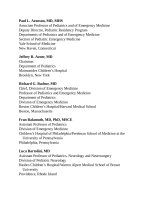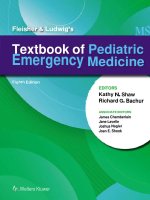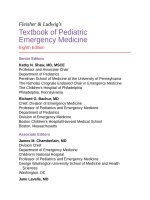Pediatric emergency medicine trisk 0333 0333
Bạn đang xem bản rút gọn của tài liệu. Xem và tải ngay bản đầy đủ của tài liệu tại đây (71.26 KB, 1 trang )
child on the lap of a parent in an ambulance, regardless of how the child is
secured to the parent or stretcher.
Lights and Siren Use
There are few times when a higher-speed transport with lights and siren (L&S)
will be of benefit to a sick or injured child—in fact, this practice may introduce
more danger than benefit to the patient. In 2019, Watanabe et al. demonstrated
that the increased odds of collision is 1.5 with L&S when compared to without.
Although in some communities it is legal for emergency vehicles to exceed the
speed limit and pass through red lights, this does not mean that it is safe to do so.
A NAEMSP position paper recommended that EMS services should develop a
policy on L&S use, which should be reviewed by the services’ medical directors.
It should be noted that accidents while running with L&S are a common cause of
litigation. Multiple vehicles responding to an incident using L&S is another
practice that is frequently done, but is likely unnecessary. Emergency vehicle
accidents are an area of high, and frequently unnecessary, liability in EMS that
are borne more out of a tradition of L&S use, than a medical necessity for the
patient. This is a good example of a nonmedical aspect of a transport system that
may adversely affect patient care.
STABILIZATION FOR TRANSPORT
The patient care paradigm of most interfacility transport teams stands somewhat
in contrast to that of prehospital care systems. EMS providers are usually
bringing a patient from an environment without medical care (e.g., home or
accident scene) to a hospital. In many of these cases, the patient is better served to
have the minimum stabilization necessary at the scene, followed by rapid
transport to an appropriate hospital, with further intervention being performed en
route or on arrival. In contrast, the interfacility transport team is most often taking
a patient from a hospital, usually an ED or another monitored setting, to a
monitored bed within a higher level or specialty care center. The transport team,
therefore, is responsible for maintaining an appropriate advanced level of care
between the two centers. Ideally, the transport team should provide the level of
care that the patient will receive at the receiving facility. At a minimum, the
transport team must maintain the patient’s present level of care. Stabilization
before transport is the key to this process.
Initial preparation for transport often begins when the referral caregivers
recognize that the patient requires care beyond the capabilities of their personnel
or center. Appropriate advice and suggestions from transport personnel or the
receiving physician ideally will enable much of the necessary stabilization,









